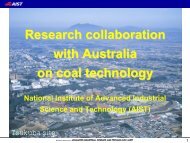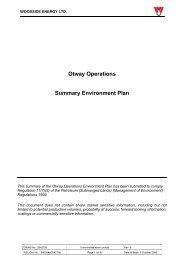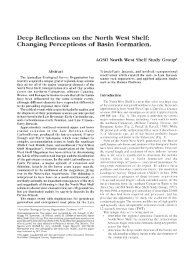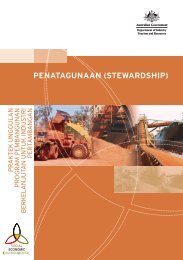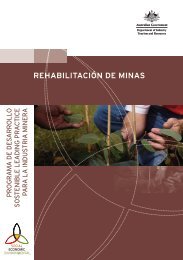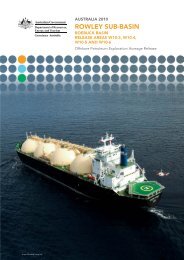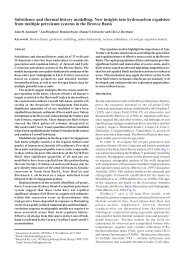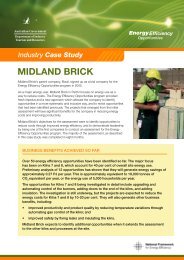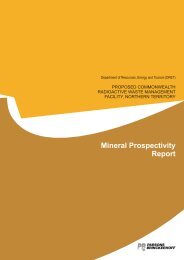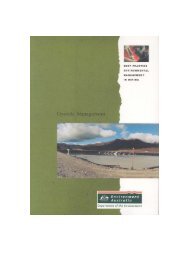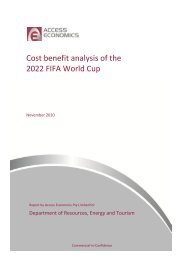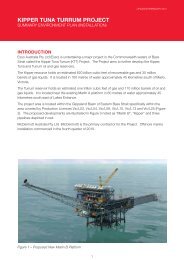A guide to leading practice sustainable development in mining
A guide to leading practice sustainable development in mining
A guide to leading practice sustainable development in mining
You also want an ePaper? Increase the reach of your titles
YUMPU automatically turns print PDFs into web optimized ePapers that Google loves.
Many examples exist where m<strong>in</strong>es provide water <strong>to</strong> community members. This<br />
can range from s<strong>to</strong>ck and domestic uses <strong>to</strong> formal supply of larger volumes for<br />
irrigation through <strong>in</strong>frastructure designed, constructed and managed by the m<strong>in</strong><strong>in</strong>g<br />
company. For example, the B<strong>in</strong>gegang pipel<strong>in</strong>e <strong>in</strong> Central Queensland supplies many<br />
s<strong>to</strong>ck and domestic users along its path of several hundred kilometres. Cadia Valley<br />
Operations manages onsite raw water s<strong>to</strong>rages <strong>to</strong> ensure downstream flow targets<br />
are met <strong>to</strong> supply agricultural needs (see LP Water p.44). Water supply can also be<br />
part of agreements associated with dewater<strong>in</strong>g. This can occur through ’make good’<br />
agreements connected <strong>to</strong> changes <strong>in</strong> hydrological conditions caused by the m<strong>in</strong>e.<br />
Prior <strong>to</strong>, dur<strong>in</strong>g, and post operations there is a need <strong>to</strong> understand the community<br />
environment—how water is used, who uses the water, seasonality of use, and exist<strong>in</strong>g<br />
and future stakeholder and community demands. Ongo<strong>in</strong>g dialogue helps these<br />
communities understand the m<strong>in</strong>e’s water needs and for the <strong>in</strong>dustry <strong>to</strong> understand<br />
community expectations when mak<strong>in</strong>g bus<strong>in</strong>ess decisions <strong>in</strong>volv<strong>in</strong>g water use. Few<br />
communities surround<strong>in</strong>g m<strong>in</strong>es will have an <strong>in</strong>tuitive grasp of the concept of m<strong>in</strong>e<br />
closure. Therefore, it is particularly important that this concept is explored with the<br />
community early <strong>in</strong> the operation and that closure plann<strong>in</strong>g <strong>in</strong>volves community<br />
throughout. This will m<strong>in</strong>imise long-term legacies with communities over unrealised<br />
expectations post closure.<br />
Community consultation and engagement techniques are discussed <strong>in</strong> the Lead<strong>in</strong>g<br />
Practice Susta<strong>in</strong>able Development Program’s Community Engagement and<br />
Development. Given the sensitivity of water for livelihood, environment and cultural<br />
support, a great deal of community engagement is likely over water-related issues,<br />
as illustrated <strong>in</strong> the Iluka case study.<br />
Water Management Plan<br />
A comprehensive site Water Management Plan (WMP) is fundamental <strong>to</strong> <strong>lead<strong>in</strong>g</strong><br />
<strong>practice</strong> water management. Its size and complexity depends on the nature of<br />
the operation, hydrology, and the cultural and environmental sensitivity of the<br />
surround<strong>in</strong>g area. It is a public statement about how <strong>to</strong> manage both operational<br />
use of water and potentially adverse impacts of operations on the local and regional<br />
water resources. The WMP identifies all water management issues associated with<br />
develop<strong>in</strong>g, operat<strong>in</strong>g and decommission<strong>in</strong>g a project. The ma<strong>in</strong> water issues <strong>to</strong> be<br />
covered at each stage of the life cycle (see Figure 2.14) are summarised <strong>in</strong> Figure<br />
2.15. Water quality issues dur<strong>in</strong>g exploration and other phases of the m<strong>in</strong><strong>in</strong>g cycle are<br />
summarised <strong>in</strong> Table 2.<br />
56 LEADING PRACTICE SUSTAINABLE DEVELOPMENT PROGRAM FOR THE MINING INDUSTRY



